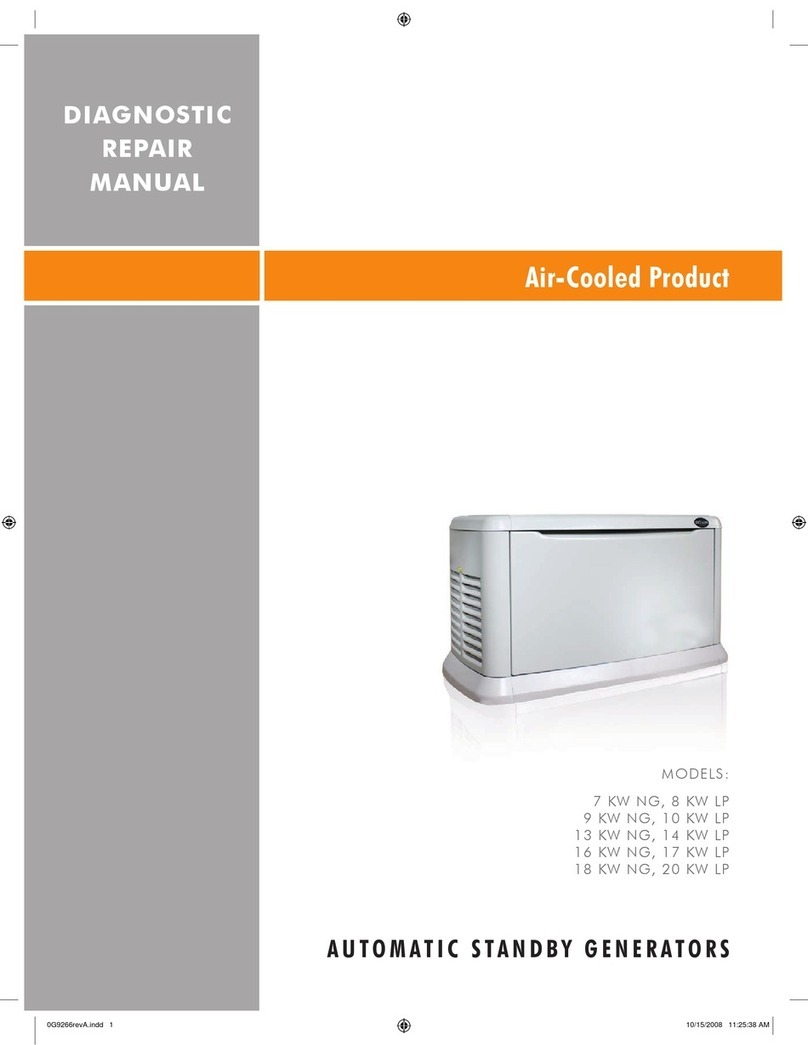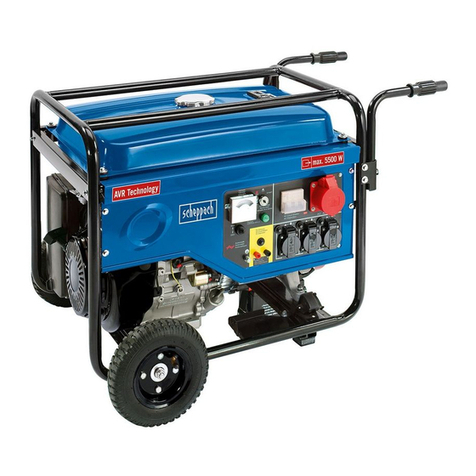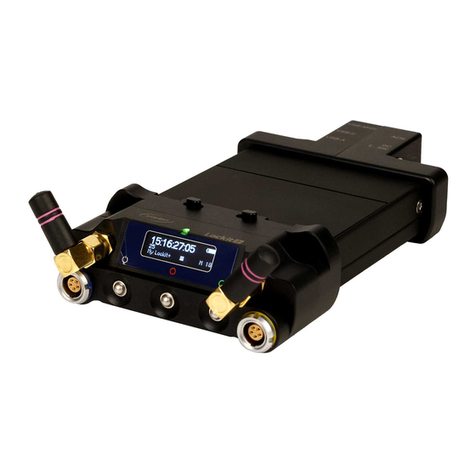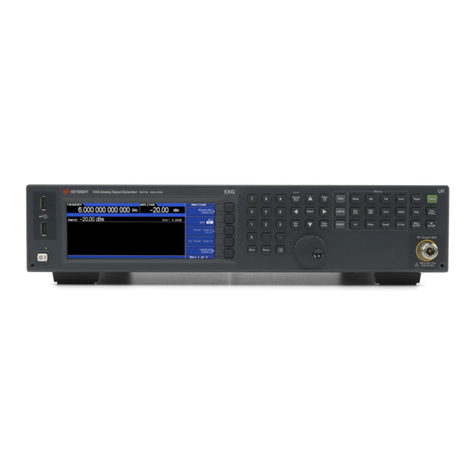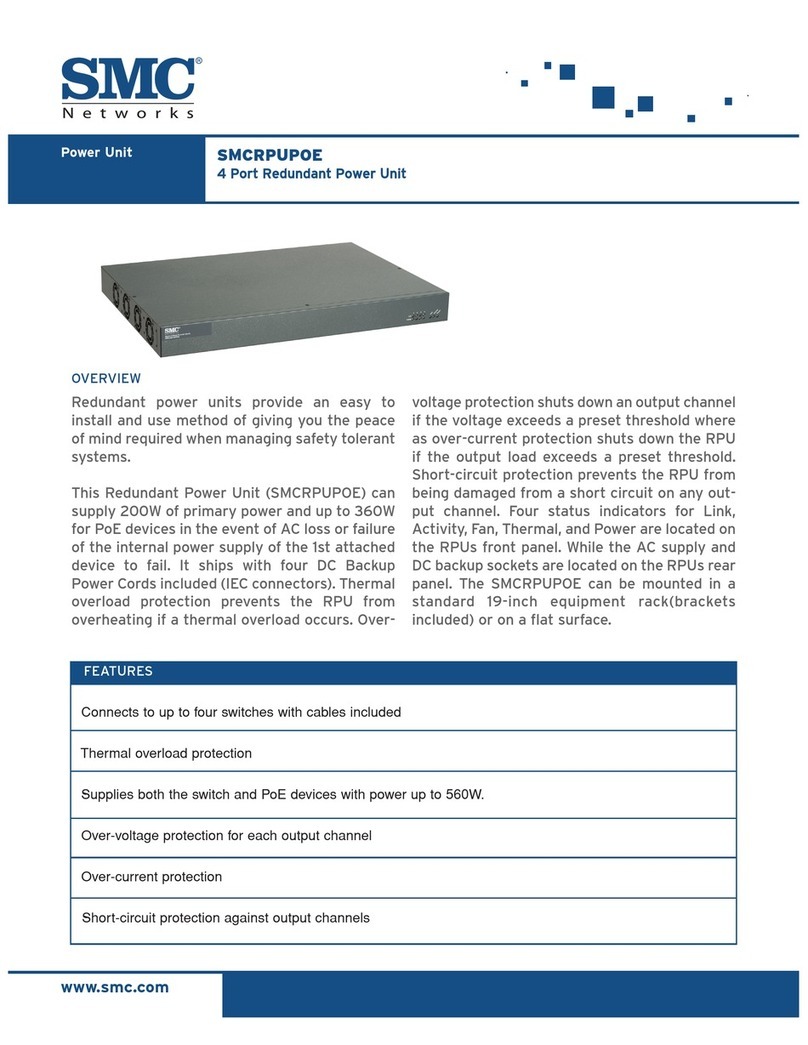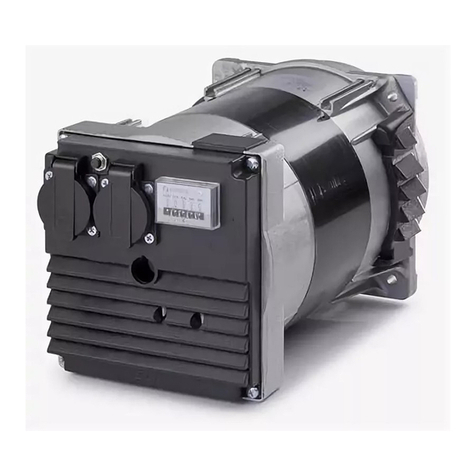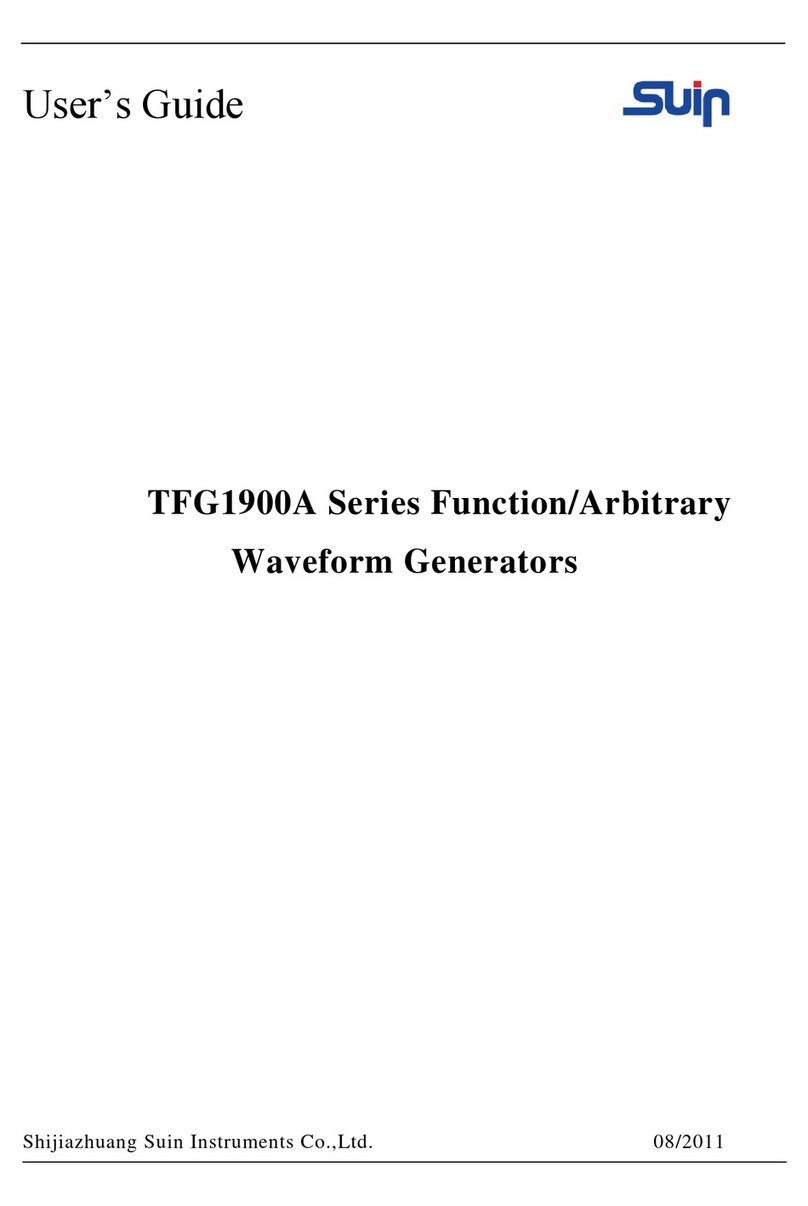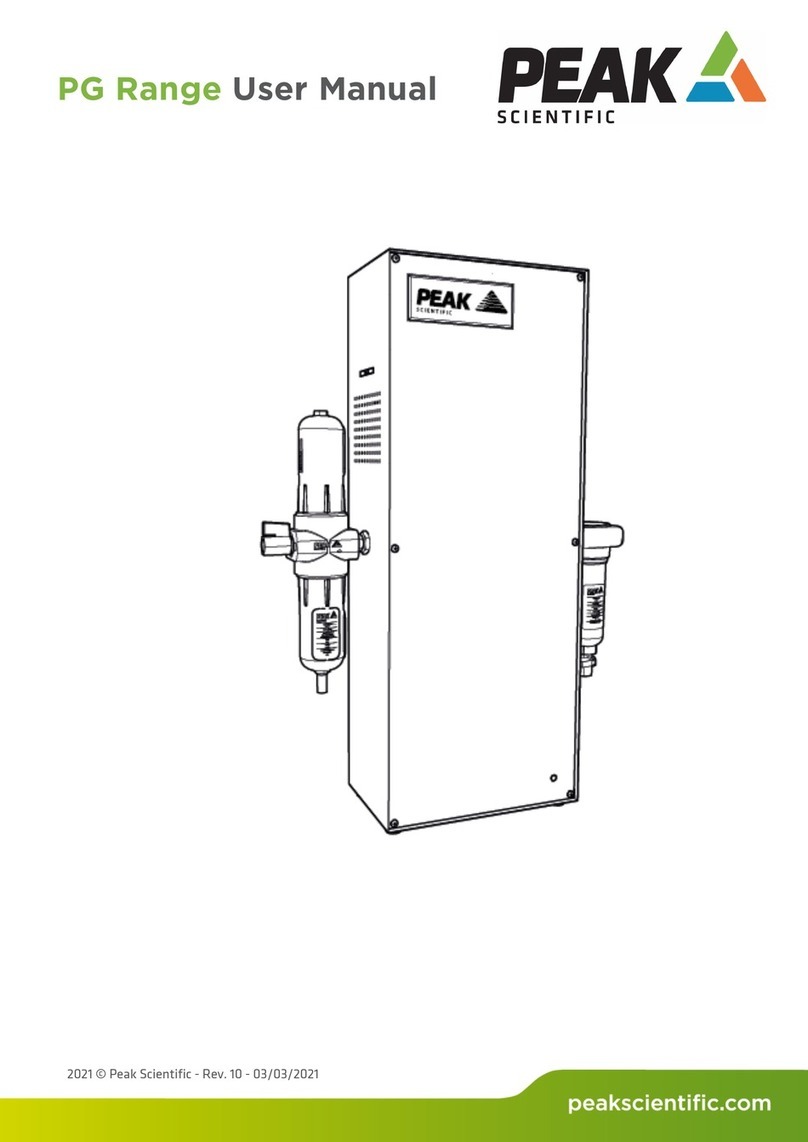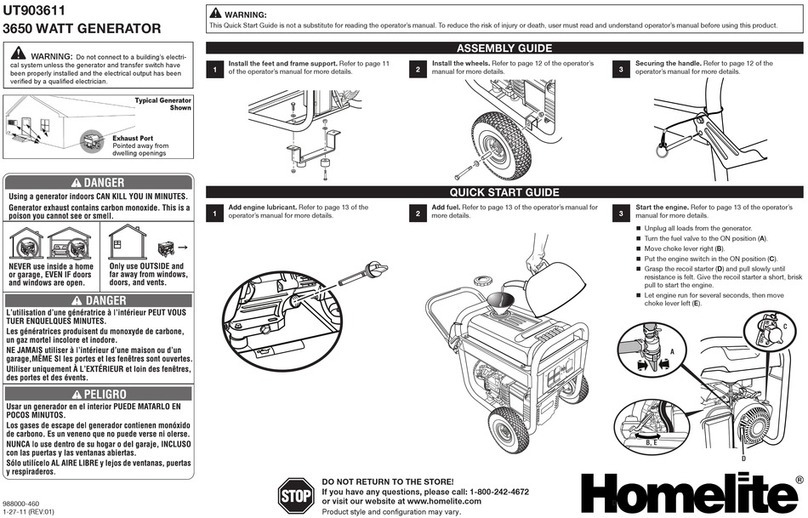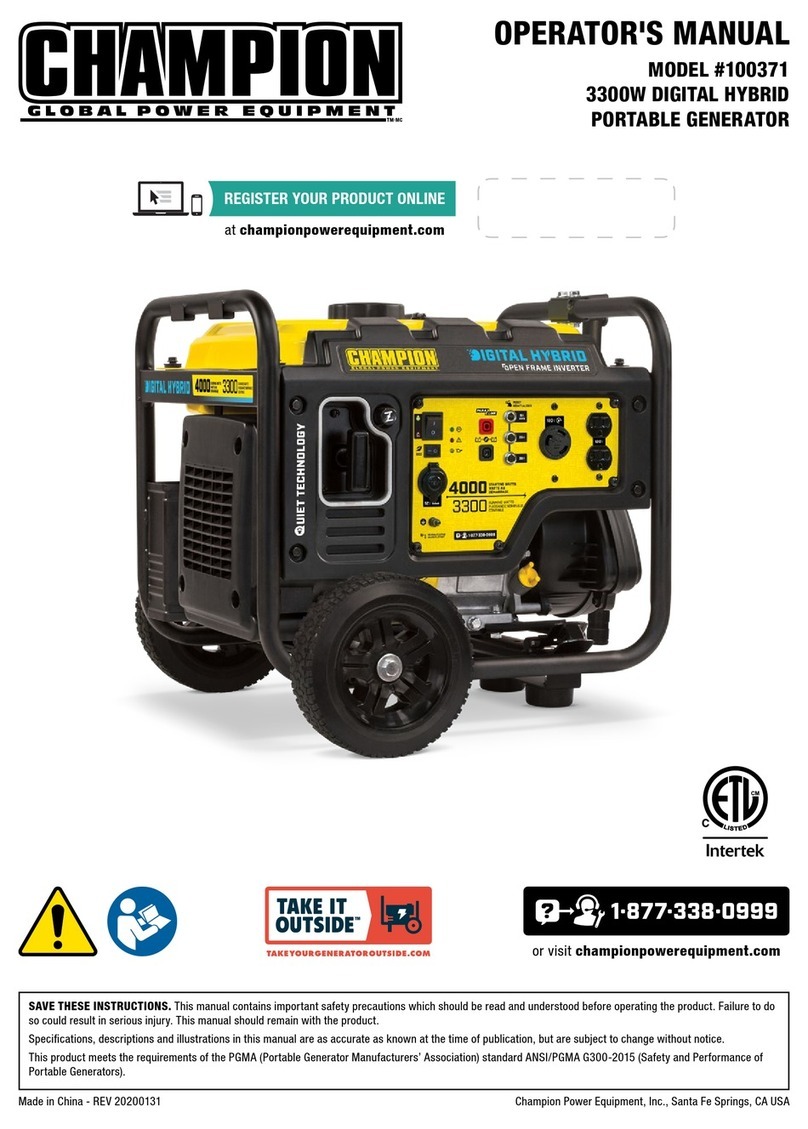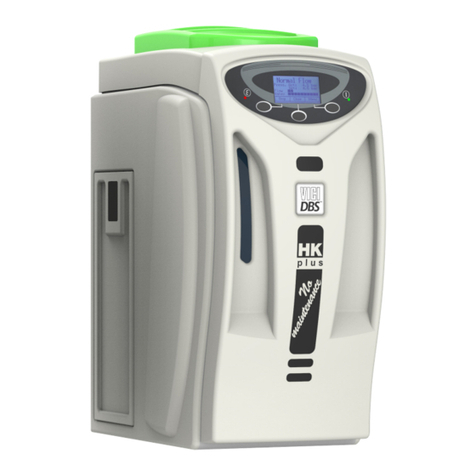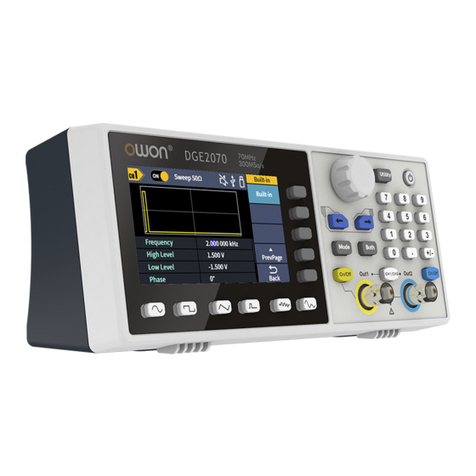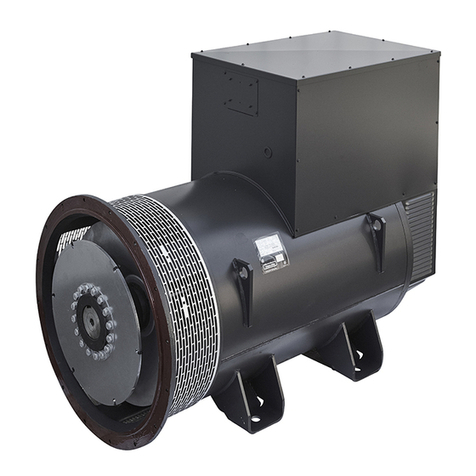Watt & Sea CRUISING 300 Quick guide

35
HYDROGENERATOR
CRUISING 300 AND CRUISING 600
Installation and instruction manual
Version
V5
Date
03/2022
Contact
Congratulations !
You have just purchased the most powerful hydrogenerator of its kind. Inspired by the requirements
of ocean racing yachts, designed to take into account the stresses experienced by monohulls, this
hydrogenerator will radically change your energy management at sea and become your main
source of power while sailing.
This product has been thoroughly inspected. The product comes with the WATT&SEA warranty
described in the "Warranty Terms" chapter of this installation guide. For traceability under the
warranty, please register the product on our website: www.wattandsea.com
Designed & manufactured in France by:
WATT&SEA SARL
3 rue Jacques Cartier
17000 La Rochelle
France
www.wattandsea.com

36
TABLE OF CONTENTS
1. SAFETY PRECAUTIONS 37
ELECTRICAL HAZARDS 37
INSTALLATION 38
OPERATION 38
2. CONTENTS OF THE HYDROGENERATOR PACK 39
3. ADDITIONAL EQUIPMENT REQUIRED 40
4. MECHANICAL INSTALLATION 41
ASSEMBLING THE PROPELLER 41
POSITIONING THE HYDROGENERATOR ON THE TRANSOM 42
INSTALLING THE BRACKET ON THE TRANSOM 44
RIGGING THE IMMERSION/LIFTING SYSTEM 45
DISMANTLING THE PROPELLER 47
MOUNTING THE ELECTRONIC CONVERTER 47
5. ELECTRICAL INSTALLATION 48
THREE-PHASE WIRING OF THE HYDROGENERATOR 48
USING A SOLAR PANEL 49
CONNECTING THE CONVERTER TO THE BATTERIES 50
INTERPRETATION OF THE CONVERTER'S LEDS52
USING BLUETOOTH 53
6. INSTALLATION SUMMARY 54
7. SPECIFICATIONS 55
TECHNICAL SPECIFICATIONS OF THE 970 MM AND 610 MM CRUISING 600 55
TECHNICAL SPECIFICATIONS OF THE 970 MM AND 610 MM CRUISING 300 56
OPERATING PRINCIPLES 57
PERFORMANCE 58
8. MAINTENANCE 60
9. LIST OF SPARES 61
10. F.A.Q 62
11. WARRANTY 64
12. FORM FOR REQUESTING AN AFTER-SALES SERVICE RETURN 65

37
1. SAFETY PRECAUTIONS
While our primary concern in designing the hydrogenerator was your safety, certain precautions
must nevertheless be taken when operating any mechanical or electrical equipment.
Please keep the following safety factors in mind when installing and operating the hydrogenerator,
and be aware at all times of the electrical and mechanical hazards inherent in operating the
propeller.
MECHANICAL HAZARDS
The hydrogenerator's blades are made of a composite material and can rotate at a speed of over
100 kph (62 mph).
At this speed, the blades are practically invisible and can cause serious injuries.
WARNING : WHEN INSTALLING THE HYDROGENERATOR, MAKE SURE THAT THE
PROPELLER IS SAFELY POSITIONED OUT OF REACH.
DO NOT ATTEMPT TO STOP THE PROPELLER WITH YOUR HAND WHILE THE
GENERATOR IS RUNNING.
Electrical hazards
Heat in wiring systems often results from undersized cables or faulty connections.
Batteries have a very high current carrying capacity. A short-circuit in their cables may result in an
outbreak of fire. To prevent this hazard, you must install a 50 amp fuse between the converter and
each battery.
If the fuse is defective, you must determine the reason before resetting or replacing it.
WARNING : YOU MUST INSTALL AN EXTERNAL 50 AMP FUSE.
WARNING : ALWAYS PLACE THE HYDROGENERATOR IN THE LIFTED POSITION
BEFORE STARTING WORK ON IT.

38
Installation
Please observe the following precautions during installation :
• Remove the hydrogenerator from the water.
• Keep safety in mind at all times ! Have someone help you throughout the duration of the
installation.
• Remember : the batteries should be connected last.
Operation
• Check the support structure, blades and electric circuits on a regular basis.
• Although the propeller blades are made of very strong materials, they may warp or
break if they come into contact with a submerged object, acting as a fuse.
WARNING : NEVER TOUCH THE PROPELLER WHEN IT IS SPINNING.
WARNING : NEVER USE THE HYDROGENERATOR TO STEP ONTO OR OFF THE BOAT
AS THIS MAY WARP THE DRIVE SHAFT.
WARNING : WHEN RUNNING, THE CONVERTER CAN REACH VERY HIGH
TEMPERATURES.

39
2. CONTENTS OF THE HYDROGENERATOR PACK
Check the contents of your pack against the list below :
-1 HYDROGENERATOR with 5 metres of cable (H-300-03 or H-600-03)
-1 LIFTING BRACKET (K-03)
-1 THREE-BLADE (P-240-03)
-1 PROPELLER EXTRACTION KIT (EP-03)
-1 CONVERTOR (CV-03) with its bag of connectors :
-1 hydrogenerator connector
-1 solar connector
-3 battery connectors (2 positive, 1
negative)
-1 LOW FRICTION RING (AN-03)
-1 LOCKING PIN (PI-03)
-1 FASTENING KIT (F-03)
-1 INSTRUCTION MANUAL
The package and its contents

40
3. ADDITIONAL EQUIPMENT REQUIRED
• Three-phase cable, minimum 3 x 1.5 mm2, for connecting the hydrogenerator to the
converter (if length < 10m; if length >10m please use 2,5mm2).
• Red and black 10 mm2cable for connecting the batteries.
• Battery terminals for the 10 mm2battery cable.
• 50 Amp fuse or thermal circuit breaker (for example : Series 187 from Blue Sea Systems)
• Junction box or waterproof connectors for three-phase cables. WATT&SEA offers an
optional connection kit with cable and waterproof power socket (Ref: PL-04).
• Bolts for fixing the bracket's stainless steel fork mountings to the hull.
• Lifting/lowering line (6:1 or 4:1 hoist, depending on boat sailing speed) with a 6 mm
diameter covered line (Refs: PA-04 and PA-04-HS).
• Install phonic insulation between the transom and the mounting bracket to minimize
vibrations (rubber sole thickness 2 to 4mm)
THE QUALITY OF THE POWER SOCKET IS PARAMOUNT : PREFERABLY CHOOSE A PLASTIC
MODEL QUALIFIED FOR 50 VCC -12 AMP.
DO NOT USE METAL POWER SOCKETS WITH BRASS CONTACTS AS THESE CORRODE TOO
QUICKLY.

41
4. MECHANICAL INSTALLATION
Your hydrogenerator is shipped partially disassembled. Please read the instruction manual
carefully before starting installation.
Assembling the propeller
• Slide the propeller onto the shaft.
• Check that the stainless steel washer (3) has been pre-mounted at the end of the
propeller. If not, insert it.
• Insert the HSHC M5x20 screw (4)
• Hold the propeller with one hand and tighten the screw using the 4 mm (5/32") Allen
key until the screw starts turning the propeller.
Exploded view of the shaft, propeller, washer and M5 screw
1 2
3 4
Hydro Mini présérie Taille C
MASSE:
ANODISATION DURE
AS7G06
A4
FEUILLE 1 SUR 1
ECHELLE:1:5
No. DE PLAN
TITRE:
REVISION
NE PAS CHANGER L'ECHELLE
MATERIAU:
DATE
SIGNATURE
NOM
CASSER LES
ANGLES VIFS
FINITION:
SAUF INDICATION CONTRAIRE:
LES COTES SONT EN MILLIMETRES
ETAT DE SURFACE:
TOLERANCES:
LINEAIRES:
ANGULAIRES:
QUAL.
FAB.
APPR.
VERIF.
AUTEUR
N
Designation
1
Shaft
2
Three-blade propeller
3
Stainless steel washer
4
M5x20HSHC screw

42
Positioning the hydrogenerator on the transom
Correctly positioning the hydrogenerator is crucial for optimizing its performance.
The following criteria must be respected during the installation :
• Immersion depth :
The hydrogenerator is supplied with a submerged aluminium leg measuring 610 mm (24 in) or
970 mm (38 in). The recommended depth between the surface and the propeller axis is 300 mm
(12 in). The greater the depth, the farther the propeller will be from the wake of the hull, and the
better the performance of the hydrogenerator. However, the most important the lever arm is, the
greater the force on the mountings and during lifting will be.
We recommend a length of 970 mm (38 in) as a satisfactory compromise for most monohull
installations.
The 610 mm leg is suitable for very large monohulls with a device installed on each side.
• Flow quality :
The quality of water flow is a key element for obtaining satisfactory power output.
N.B. : Do not position the hydrogenerator directly in the wake of an appendage
or too close to a saildrive.
Wherever possible, position the hydrogenerator several inches to the side, in order to offset it from
the rudder, the propeller or other appendix.
Example of installation with the longer leg (970 mm / 38 in) :
Installation on a 10 m (33 ft) Figaro II heeling at 20° (CFD by CRAIN)
The length of 970 mm is enough for it to be immersed properly during listing because the loss of
speed due to the wake is about 5%.

43
• Examples of installations with the shorter leg (610 mm / 24 in) :
Dual installation on a Pogo40 (© CN STRUCTURES)
The hydrogenerators are placed parallel to the rudders but approximately 30 cm (12 in) to the
inside to avoid their wakes.
Installation on a catamaran (© OUTREMER YACHTING)
Here, the hydrogenerator is positioned to the side, out of the wake of the nearby rudder.

44
Installing the bracket on the transom
Depending on your boat's transom, its structure might need to be reinforced to take the stress on
the mountings. Phonic insulation also reduces vibrations.
WARNING : Due to the size of the lever arm, the maximum theoretical stress on
the bracket's fork mountings is estimated at around 300 kg. Your mounting
system should be adapted accordingly.
The bracket must be adapted to the 8 mm diameter fork mountings that are securely mounted onto
the transom.
These fork mountings must be mounted in such a way as to compensate for any tilt of the transom.
The diagram below will help you to adapt the mountings to your boat.
N.B. : The leg must be vertical in the lowered position, leading edge abutting
lower gudgeon.
Lifting Bracket dimensions

45
Rigging the immersion/lifting system
The hydrogenerator is supplied with a lifting bracket that functions in a similar way to the systems
used on the rudders. It facilitates access to the propeller when the device is lifted, for the removal
of seaweed for example.
The lowering and lifting procedures are carried out using a hoist which is not included in the pack.
The maximum traction during lifting is around 40 kg. It is therefore recommended to rig a 4:1 to
6:1 hoist with a 6 mm diameter sheathed line (hoist available in option at Watt&Sea, refs: PA-04
and PA-04-HS, depending on boat sailing speed).
• Assembly of the lowering rope (as per blue line below):
Pass the rope successively :
-in the cam-cleat of the bracket
-in the two gudgeons of the bracket
-through the low friction ring
-in the hole of the lower gudgeon
-Finish the assembly by an eight-knot (see picture below)
• Assembly of the lifting rope ; please see in green below
•
Assembly of the lowering line using a low friction ring

46
The cleat integrated into the bracket is used to lock the lowering and lifting line. For permanent
blocking in lower position, you can use the locking pin.
Please take care in pull in a vertical way on the immersion and lifting lines to avoid the cleat from
opening unexpectedly.
N.B. : When the hydrogenerator is submerged, the leg should sit flush in the
groove of the gudgeon provided for this purpose. If this is not the case, the lateral
support will be less efficient, and this may result in mechanical damage.
It is also advisable to hold the lifting end in place using an elastic cord to prevent it from leaving
the groove.
Lifting the hydrogenerator

47
Dismantling the propeller
To dismantle the propeller, you should use the M6 extractor screw (supplied with the
hydrogenerator.)
• Unscrew the M5 screw that holds the propeller at the end of the shaft.
• In its place, insert the M6 screw and tighten it using the appropriate key. This will have
the effect of effortlessly removing the propeller from its conical fitting.
N.B. : Any method for dismantling the propeller other than the one described
above may result in damage to the hydrogenerator.
Mounting the electronic converter
The electronic converter is a box which is resistant to splashes and passive ventilation, guaranteeing
long-term protection even in humid environments.
The converter must nevertheless be installed inside the boat, preferably in the mechanical room in
close proximity to the batteries.
WARNING : WHEN RUNNING, THE CONVERTER CAN REACH VERY HIGH
TEMPERATURES. AS SUCH, ASSEMBLY SHOULD BE CARRIED OUT IN A VENTILATED
SPACE.
N.B. : To ensure proper ventilation, the converter must be mounted on a vertical
bulkhead, with the ventilation grids in a vertical position.
If you wish to get an access to the converter’s status, keep in mind to get a visual
access to the LEDS located on the top (white cover)
As it is so light, the converter can be securely attached using the Velcro provided.
• degrease the surface on which the converter will be installed
• remove the protective tabs of the strips of Velcro provided on the
converter
• apply the quick-drying glue if the surface is very uneven (against
plywood, fibreglass ...)
• firmly attach the converter to the surface

48
5. ELECTRICAL INSTALLATION
Recommendations for electrical connections :
Please consult local/national safety rules before installation.
All electric cables must be carefully insulated. For maximum protection, cover the cables with
electrical cable sheaths.
WARNING : CONNECTIONS MUST BE INSPECTED REGULARLY TO DETECT SIGNS OF
CORROSION AND CLEANED WHEN NECESSARY. DAMAGED OR CORRODED
CONNECTIONS LEAD TO A SIGNIFICANT DROP IN PRODUCTION.
Wiring principle
Three-phase wiring of the hydrogenerator
WARNING : ALWAYS PLACE THE HYDROGENERATOR IN THE LIFTED POSITION
BEFORE STARTING WORK ON IT.
The hydrogenerator is fitted with a small diameter electrical cable of sufficient length to pass
through the transom. This is a three-phase cable.
§ We recommend using the connection kit with a cable and waterproof power socket.
(Ref. PL-04).
§ From here, use a three-phase cable to connect the hydrogenerator to the converter. If the
length of this cable is less than 10 metres, use a 3 x 1.5 mm2section. Above 10 metres, use
a 3 x 2.5 mm2section.
§ The converter is connected using the connector kit provided. Connect the 3 phases on one of
the premounted plugs supplied (Ref. CA-03). There is no importance in the connection
arrangement of the 3 other wires (BROWN, ORANGE, RED). The black wire must not be
connected, it is used to wire a solar panel (please see below). You can connect them with for
example WAGO 222 connectors. See the assembly instructions below.
Junction box (not provided))
Three-phase cable (not provided)
Converter
Auxiliary batteries
Positive cable
Negative cable
Three-phase cable (3 x 25mm²)
or connection kit (option WATT&SEA)
Optional connexion kit

49
Converter’s connections
N.B. : Using a cable that is less than 3 x 1.5 mm2in diameter will affect both the
output and the performance of the hydrogenerator.
The GND position must not be connected (ground terminal).
N.B. : The phase sequence is irrelevant. Therefore, there is no need to take into
account the color or numbering of the cables.
Using a solar panel
The converter has 2 inputs : one for the hydrogenerator and one for the solar panel. The solar
panel's maximum voltage must not exceed 50 VCC and the intensity must not exceed 14 amps.
Minimum voltage to start producing with the solar panels is 7,5VCC.
Wire the solar panel using the 2nd premounted plug CA-03, taking care of the polarity:
NEGATIVE SOLAR: BLACK
POSITIVE SOLAR: RED
WARNING : RESPECT THE POLARITY OF THE SOLAR PANEL
not used / non utilisé
(female contact /contact femelle)
(female contact /contact femelle)
(female contact / contact femelle)
(male contact / contact mâle)
not used / non utilisé
heat shrinking tube
heat shrinking tube
HYDROGENERATOR CONNECTOR
Phases : RED, ORANGE, BROWN (Rouge, Orange, Marron)
Not used : BLACK (Noir non utilisé)
SOLAR CONNECTOR
Positive : RED max 50V in open circuit (Rouge, max 50V)
Negative : BLACK common with battery negative (Noir)
Not used : ORANGE, BROWN (Orange, Marron non utilisés)
BATT #1 POSITIVE
POSITIF BATTERIE N ° 1
BATT #2 POSITIVE
POSITIF BATTERIE N ° 2
COMMON BATT NEGATIVE
NEGATIF COMMUN
–

50
When the hydrogenerator and the solar panel generate power at the same time, priority is given
to the hydrogenerator. As soon as this is no longer generating power (lifted, the boat is moored)
the converter automatically takes into account the solar panel's charge.
Connecting the converter to the batteries
The converter must be placed as close as possible to the batteries in order to minimize losses due
to cable length. The maximum recommended distance is 2 metres.
The batteries are connected to the converter via a solar connector supplied.
The converter has an internal 2 output isolator that makes it possible to charge two battery units
separately. The 2 battery banks must be at the same voltage.
WARNING : RISK OF OVERLOADING AND FIRE. THE TWO BATTERY BANKS MUST
BE THE SAME TYPE AND HAVE THE SAME VOLTAGE.
WARNING : EACH BATTERY BANK MUST BE PROTECTED WITH A 50 AMP FUSE.
We recommend connecting the hydrogenerator's converter directly to the service battery bank.
The converter will monitor the batteries independently of the other on-board units, and will charge
them when required.
N.B. : Proper operation on one external battery isolator is not guaranteed and
may require additional adjustment. Please contact your distributor.
WARNING : NEVER REVERSE THE POLARITY OF THE CONVERTER. THIS WILL LEAD
TO THE DESTRUCTION OF THE DEVICE.
Please see on next page to properly dismount the solar connectors from the converter.

51
© PHOENIX CONTACT 2012-07-11 MNR 0125154 - 01 10488301
PV-CF-S6-16 (+)...
PV-CM-S6-16 (-)...
DE Einbauanweisung
EN Installation notes
FR Instructions d'installation
IT Istruzioni di installazione
ES Instrucciones de montaje
PT Instruções de instalação
RU
TR Montaj talimatı
ZH
PHOENIX CONTACT GmbH & Co. KG
32823 Blomberg, Germany
Phone +49-(0)5235-3-00
www.phoenixcontact.com
SUNCLIX-Photovoltaik-Steckverbinder
zum Einsatz in Photovoltaik-Anlagen
für
6...16mm
²-Solarkabel vom
Typ PV1-F
1 Sicherheitshinweise
WARNUNG: Die SUNCLIX-Steckverbin-
der dürfen ausschließlich durch elektro-
technisch unterwiesene Personen
angeschlossen werden.
WARNUNG: Stecken oder trennen Sie die
SUNCLIX-Steckverbinder niemals unter
Last.
ACHTUNG: Verwenden Sie die Steckver-
binder nur zusammen mit einem
6 ... 16 mm²-Solarkabel vom Typ PV1-F.
Nur mit diesem Kabel ist der sichere elekt-
rische Anschluss gewährleistet.
Beachten Sie beim Verlegen der Kabel die
Biegeradien, die der Hersteller vorgibt.
ACHTUNG: Verbinden Sie diese Steck-
verbinder nur mit anderen SUNCLIX-
Photovoltaik-Steckverbindern. Beachten
Sie bei dem Verbinden unbedingt die An-
gaben zu Nennspannung und Nennstrom.
Der kleinste gemeinsame Wert ist zuläs-
sig.
ACHTUNG: Schützen Sie die Steckver-
binder vor Feuchtigkeit und Schmutz.
–Tauchen Sie die Steckverbinder nicht un-
ter Wasser.
–Verlegen Sie den Stecker nicht direkt auf
der Dachhaut.
–Versehen Sie die Steckverbinder, die nicht
gesteckt sind, mit einer Schutzkappe (z. B.
PV-C PROTECTION CAP, Artikel-Nr.
1785430).
2Steckverbinder anschließen
Sie benötigen einen Schlitz-Schraubendreher mit
3-mm-breiter Klinge (z. B. SZF 1-0,6X3,5;
Artikel-Nr. 1204517).
2.1 Kabel anschließen (Bild )
• Isolieren Sie das Kabel mit einem geeigneten
Werkzeug um 18 mm ab. Achten Sie darauf,
dabei keine Einzeldrähte abzuschneiden.
1Führen Sie die abisolierte Ader sorgfältig bis
zum Anschlag ein. Die Litzenenden müssen in
der Feder sichtbar sein.
2Schließen Sie die Feder. Stellen Sie sicher,
dass die Feder eingerastet ist.
3Schieben Sie den Einsatz in die Hülse.
4Ziehen Sie die Kabelverschraubung mit 3 Nm
an.
2.2 Steckverbinder zusammen fügen
•Führen Sie Stecker und Buchse zusammen.
Dabei rastet die Verbindung ein.
• Ziehen Sie an der Kupplung, um die korrekte
Verbindung zu prüfen.
3 Steckverbinder trennen (Bild )
1Führen Sie den Schraubendreher ein, wie in
Bild gezeigt.
2Lassen Sie den Schraubendreher stecken und
trennen Sie Buchse und Stecker voneinander.
3.1 Kabel lösen (Bild )
1Drehen Sie die Kabelverschraubung auf.
2Führen Sie den Schraubendreher an der in
Bild gezeigten Position ein.
3Hebeln Sie die Verbindung auf und ziehen Sie
Hülse und Einsatz auseinander.
4Öffnen Sie die Feder mit dem Schraubendre-
her.
5Entfernen Sie das Kabel.
4 Technische Daten
Umgebungstemperatur: -40 °C... +90 °C
Nennspannung: max. 1500 V DC
Nennstrom: 40 A (6 mm²), 50 A (10 mm²),
65 A (16 mm²)
Kabeldurchmesser: 5,5 ...10 mm
SUNCLIX photovoltaic I/O connector
for installation in photovoltaic systems
for
6...16
mm² solar cables, type PV1-F
1Safety notes
WARNING:The SUNCLIX plug-in connec-
tors may be connected only by trained
electricians.
WARNING:Never plug in or disconnect
the SUNCLIX plug-in connectors under
load.
NOTE: Use these plug-in connectors only
in combination with a 6 ... 16 mm² solar ca-
ble, type PV1-F. A safe, electrical connec-
tion is only possible with this cable.
When laying out the cable, observe the
bending radiuses that the manufacturer
specifies.
NOTE: Connect this plug-in connector
only with other SUNCLIX photovoltaic
plug-in connector. When making the con-
nections, be sure to observe the specifica-
tions on nominal voltage and nominal
current. The smallest common value is
permissible.
NOTE: Protect the plug-in connectors
from humidity and dirt.
– Do not immerse the plug-in connector in
water.
–Never lay out the plug directly on the roof-
ing.
–Attach a protective cap (e.g.
PV-C PROTECTION CAP, order number
1785430) to plug-in connectors that are
not plugged in.
2 Connecting connectors
You need a slot screwdriver with a 3-mm wide
blade (e.g. SZF 1-0.6X3.5; item no. 1204517).
2.1 Connecting the cable (Fig. )
•Strip the cable by 18 mm with a suitable tool.
Make sure that no individual wires are cut off.
1Carefully insert the stripped wire all the way in.
The litz wire ends have to be visible in the
spring.
2Close the spring. Make sure that the spring is
snapped in.
3Push the insert into the sleeve.
4Tighten the cable gland to 3 Nm.
2.2 Assemble the connector
•Bring the plug and the socket together. The
connection snaps close thereby.
•Pull on the coupling to check the proper con-
nection.
3 Separating the connector (Fig )
1Insert the screwdriver as shown in Fig. .
2Leave screwdriver inserted and disconnect the
plug and the socket from each other.
3.1 Loosen the cable (Fig. )
1Screw open the cable gland.
2Insert the screwdriver at the position shown in
Fig. .
3Pry the connection open and pull the sleeve
and the insert apart.
4Open the spring with the screwdriver.
5Remove the cable.
4 Technical data
Ambient temperature: -40 °C ... +90 °C
Nominal voltage: max. 1500 V DC
Nominal current: 40 A (6 mm²), 50 A (10 mm²),
65 A (16 mm²)
Cable diameter: 5,5 ...10 [mm]
Connecteur photovoltaïque SUNCLIX
destiné aux câbles pour système à
énergie solaire de 6 ... 16 mm²,
type PV1-F
1Consignes de sécurité
ATTENTION : Seules des personnes dû-
ment formées en électrotechnique sont
autorisées à installer les connecteurs
mâles SUNCLIX.
ATTENTION : Les connecteurs SUNCLIX
ne doivent jamais être connectés ni dé-
connectés en charge.
IMPORTANT : Utiliser ces connecteurs
uniquement avec des câbles pour sys-
tème à énergie solaire de 6 ... 16 mm² et
de type PV1-F. Seul ce câble garantit la
sécurité électrique du raccordement.
Lors de la pose du câble, respecter les
rayons de courbure prescrits par le fabri-
cant.
IMPORTANT : Raccorder ces connec-
teurs mâles uniquement avec d'autres
connecteurs photovoltaïques SUNCLIX.
Lors du raccordement, respecter impérati-
vement les valeurs données pour la ten-
sion nominale et pour l'intensité nominale.
Le plus petit dénominateur commun est
admis.
IMPORTANT : Protéger les connecteurs
mâles de l'humidité et de la saleté.
– Ne jamais plonger les connecteurs mâles
dans l'eau.
–Ne jamais poser directement le connec-
teur sur la peau du toit.
– Equiper les connecteurs mâles non enfi-
chés d'un capuchon de protection (par ex.
PV-C PROTECTION CAP, référence
1785430).
2 Raccordement du connecteur
Un tournevis à fente à lame large de 3 mm est re-
quis (par ex. SZF 1-0,6X3,5 ; référence1204517).
2.1 Raccordement du câble (Figure )
•Dénuder le câble sur 18mm avec un outil ap-
proprié. Veiller à ne sectionner aucun fil du
câble.
1Introduire le fil dénudé avec prudence jusqu'en
butée. Les extrémités des torons doivent appa-
raître dans le « tiroir » à ressort.
2Refermer le « tiroir » à ressort. Vérifier qu'il est
bien encliqueté.
3Enfiler le raccord dans le manchon.
4Serrer le presse-étoupe à 3 Nm.
2.2 Assemblage du connecteur mâle
•Assembler le connecteur et le connecteur fe-
melle. Veiller à ce que la connexion s'encli-
quète.
•Exercer une traction des deux côtés du raccor-
dement pour en vérifier la solidité.
3 Déconnexion du connecteur mâle
(Figure )
1Introduire un tournevis comme indiqué à la Fi-
gure .
2Laisser le tournevis en place et séparer le
connecteur mâle du connecteur femelle.
3.1 Séparation du câble (Figure )
1Dévisser le raccord vissé du câble.
2Introduire le tournevis à l'emplacement indiqué
à la Figure .
3Soulever la connexion puis séparer le man-
chon du raccord.
4Ouvrir le « tiroir » à ressort avec le tournevis.
5Extraire le câble de la connexion.
4 Caractéristiques techniques
Température ambiante : -40 °C ... +90 °C
Tension nominale : 1500 V DC max.
Intensité nominale : 40 A (6 mm²), 50 A (10 mm²),
65 A (16 mm²)
Diamètre de câble : 5,5 ...10 mm
Connettore fotovoltaico SUNCLIX per
l'utilizzo in impianti fotovoltaici per cavi
solari da
6...16mm
² del tipo PV1-F
1 Avvertenze di sicurezza
AVVERTENZA: I connettori SUNCLIX de-
vono essere collegati solo da persone che
operano sotto la supervisione di elettricisti
specializzati.
AVVERTENZA: Collegare o scollegare i
connettori SUNCLIX soltanto in assenza di
carico.
IMPORTANTE: Utilizzare questi connetto-
ri soltanto insieme a un cavo solare da
6...16mm² del tipo PV1-F. Solo con que-
sto cavo si garantisce un collegamento
elettrico sicuro.
Per la posa del cavo rispettare i raggi di
curvatura prescritti dal produttore.
IMPORTANTE: Collegare questi connet-
tori soltanto con altri connettori fotovoltaici
SUNCLIX. Per il collegamento rispettare
assolutamente le indicazioni sulla tensio-
ne nominale e la corrente nominale. È per-
messo il più piccolo valore comune.
IMPORTANTE: Proteggere dalla polvere
e dall'umidità i connettori.
– Non immergere in acqua i connettori.
–Non posare il connettore direttamente sul
manto di copertura del tetto.
– Applicare un cappuccio di sicurezza
(ad es. PV-C PROTECTION CAP, codice
1785430) ai connettori non collegati.
2Connessione
È necessario un cacciavite per viti a taglio con una
punta larga 3 mm (ad es. SZF 1-0,6X3,5;
codice 1204517).
2.1 Collegamento del cavo (figura )
•Spelare il cavo di 18 mm con un utensile adat-
to. Eseguendo questa operazione, fare atten-
zione a non tagliare i conduttori singoli.
1Inserire con cura il conduttore spelato fino a
battuta. Le estremità dei cavetti devono essere
visibili nell'elemento di bloccaggio a molla.
2Chiudere l'elemento di bloccaggio a molla. Ve-
rificare che scatti.
3Infilare l'inserto nel capocorda.
4Serrare la connessione a vite per cavo con una
coppia di 3 Nm.
2.2 Unione dei connettori
•Congiungere assieme connettore maschio e
connettore femmina. I connettori si innestano.
•Tirare il giunto per verificare che il collegamen-
to sia corretto.
3 Separazione dei connettori
(figura )
1Inserire il cacciavite come indicato in figura .
2Lasciare inserito il cacciavite e scollegare il
connettore femmina dal connettore maschio.
3.1 Scollegamento del cavo (figura )
1Svitare la connessione a vite per cavo.
2Inserire il cacciavite nella posizione indicata
nella figura .
3Fare leva sul collegamento e staccare il con-
nettore femmina dall'inserto.
4Aprire l'elemento di bloccaggio a molla con il
cacciavite.
5Rimuovere il cavo.
4Dati tecnici
Temperatura ambiente: -40 °C ... +90 °C
Tensione nominale: max. 1500 V DC.
Corrente nominale: 40 A (6 mm²), 50 A (10 mm²),
65 A (16 mm²)
Diametro cavo: 5,5 ...10 mm
1
2
3
3Nm
4
18
18
2
1
EnglishFrançaisItaliano Deutsch
© PHOENIX CONTACT 2012-07-11 MNR 0125154 - 01 10488301
PV-CF-S6-16 (+)...
PV-CM-S6-16 (-)...
DE Einbauanweisung
EN Installation notes
FR Instructions d'installation
IT Istruzioni di installazione
ES Instrucciones de montaje
PT Instruções de instalação
RU
TR Montaj talimatı
ZH
PHOENIX CONTACT GmbH & Co. KG
32823 Blomberg, Germany
Phone +49-(0)5235-3-00
www.phoenixcontact.com
SUNCLIX-Photovoltaik-Steckverbinder
zum Einsatz in Photovoltaik-Anlagen
für
6...16mm
²-Solarkabel vom
Typ PV1-F
1 Sicherheitshinweise
WARNUNG: Die SUNCLIX-Steckverbin-
der dürfen ausschließlich durch elektro-
technisch unterwiesene Personen
angeschlossen werden.
WARNUNG: Stecken oder trennen Sie die
SUNCLIX-Steckverbinder niemals unter
Last.
ACHTUNG: Verwenden Sie die Steckver-
binder nur zusammen mit einem
6 ... 16 mm²-Solarkabel vom Typ PV1-F.
Nur mit diesem Kabel ist der sichere elekt-
rische Anschluss gewährleistet.
Beachten Sie beim Verlegen der Kabel die
Biegeradien, die der Hersteller vorgibt.
ACHTUNG: Verbinden Sie diese Steck-
verbinder nur mit anderen SUNCLIX-
Photovoltaik-Steckverbindern. Beachten
Sie bei dem Verbinden unbedingt die An-
gaben zu Nennspannung und Nennstrom.
Der kleinste gemeinsame Wert ist zuläs-
sig.
ACHTUNG: Schützen Sie die Steckver-
binder vor Feuchtigkeit und Schmutz.
–Tauchen Sie die Steckverbinder nicht un-
ter Wasser.
–Verlegen Sie den Stecker nicht direkt auf
der Dachhaut.
–Versehen Sie die Steckverbinder, die nicht
gesteckt sind, mit einer Schutzkappe (z. B.
PV-C PROTECTION CAP, Artikel-Nr.
1785430).
2Steckverbinder anschließen
Sie benötigen einen Schlitz-Schraubendreher mit
3-mm-breiter Klinge (z. B. SZF 1-0,6X3,5;
Artikel-Nr. 1204517).
2.1 Kabel anschließen (Bild )
• Isolieren Sie das Kabel mit einem geeigneten
Werkzeug um 18 mm ab. Achten Sie darauf,
dabei keine Einzeldrähte abzuschneiden.
1Führen Sie die abisolierte Ader sorgfältig bis
zum Anschlag ein. Die Litzenenden müssen in
der Feder sichtbar sein.
2Schließen Sie die Feder. Stellen Sie sicher,
dass die Feder eingerastet ist.
3Schieben Sie den Einsatz in die Hülse.
4Ziehen Sie die Kabelverschraubung mit 3 Nm
an.
2.2 Steckverbinder zusammen fügen
•Führen Sie Stecker und Buchse zusammen.
Dabei rastet die Verbindung ein.
• Ziehen Sie an der Kupplung, um die korrekte
Verbindung zu prüfen.
3 Steckverbinder trennen (Bild )
1Führen Sie den Schraubendreher ein, wie in
Bild gezeigt.
2Lassen Sie den Schraubendreher stecken und
trennen Sie Buchse und Stecker voneinander.
3.1 Kabel lösen (Bild )
1Drehen Sie die Kabelverschraubung auf.
2Führen Sie den Schraubendreher an der in
Bild gezeigten Position ein.
3Hebeln Sie die Verbindung auf und ziehen Sie
Hülse und Einsatz auseinander.
4Öffnen Sie die Feder mit dem Schraubendre-
her.
5Entfernen Sie das Kabel.
4 Technische Daten
Umgebungstemperatur: -40 °C... +90 °C
Nennspannung: max. 1500 V DC
Nennstrom: 40 A (6 mm²), 50 A (10 mm²),
65 A (16 mm²)
Kabeldurchmesser: 5,5 ...10 mm
SUNCLIX photovoltaic I/O connector
for installation in photovoltaic systems
for
6...16
mm² solar cables, type PV1-F
1Safety notes
WARNING:The SUNCLIX plug-in connec-
tors may be connected only by trained
electricians.
WARNING:Never plug in or disconnect
the SUNCLIX plug-in connectors under
load.
NOTE: Use these plug-in connectors only
in combination with a 6 ... 16 mm² solar ca-
ble, type PV1-F. A safe, electrical connec-
tion is only possible with this cable.
When laying out the cable, observe the
bending radiuses that the manufacturer
specifies.
NOTE: Connect this plug-in connector
only with other SUNCLIX photovoltaic
plug-in connector. When making the con-
nections, be sure to observe the specifica-
tions on nominal voltage and nominal
current. The smallest common value is
permissible.
NOTE: Protect the plug-in connectors
from humidity and dirt.
– Do not immerse the plug-in connector in
water.
–Never lay out the plug directly on the roof-
ing.
–Attach a protective cap (e.g.
PV-C PROTECTION CAP, order number
1785430) to plug-in connectors that are
not plugged in.
2 Connecting connectors
You need a slot screwdriver with a 3-mm wide
blade (e.g. SZF 1-0.6X3.5; item no. 1204517).
2.1 Connecting the cable (Fig. )
•Strip the cable by 18 mm with a suitable tool.
Make sure that no individual wires are cut off.
1Carefully insert the stripped wire all the way in.
The litz wire ends have to be visible in the
spring.
2Close the spring. Make sure that the spring is
snapped in.
3Push the insert into the sleeve.
4Tighten the cable gland to 3 Nm.
2.2 Assemble the connector
•Bring the plug and the socket together. The
connection snaps close thereby.
•Pull on the coupling to check the proper con-
nection.
3 Separating the connector (Fig )
1Insert the screwdriver as shown in Fig. .
2Leave screwdriver inserted and disconnect the
plug and the socket from each other.
3.1 Loosen the cable (Fig. )
1Screw open the cable gland.
2Insert the screwdriver at the position shown in
Fig. .
3Pry the connection open and pull the sleeve
and the insert apart.
4Open the spring with the screwdriver.
5Remove the cable.
4 Technical data
Ambient temperature: -40 °C ... +90 °C
Nominal voltage: max. 1500 V DC
Nominal current: 40 A (6 mm²), 50 A (10 mm²),
65 A (16 mm²)
Cable diameter: 5,5 ...10 [mm]
Connecteur photovoltaïque SUNCLIX
destiné aux câbles pour système à
énergie solaire de 6 ... 16 mm²,
type PV1-F
1Consignes de sécurité
ATTENTION : Seules des personnes dû-
ment formées en électrotechnique sont
autorisées à installer les connecteurs
mâles SUNCLIX.
ATTENTION : Les connecteurs SUNCLIX
ne doivent jamais être connectés ni dé-
connectés en charge.
IMPORTANT : Utiliser ces connecteurs
uniquement avec des câbles pour sys-
tème à énergie solaire de 6 ... 16 mm² et
de type PV1-F. Seul ce câble garantit la
sécurité électrique du raccordement.
Lors de la pose du câble, respecter les
rayons de courbure prescrits par le fabri-
cant.
IMPORTANT : Raccorder ces connec-
teurs mâles uniquement avec d'autres
connecteurs photovoltaïques SUNCLIX.
Lors du raccordement, respecter impérati-
vement les valeurs données pour la ten-
sion nominale et pour l'intensité nominale.
Le plus petit dénominateur commun est
admis.
IMPORTANT : Protéger les connecteurs
mâles de l'humidité et de la saleté.
– Ne jamais plonger les connecteurs mâles
dans l'eau.
–Ne jamais poser directement le connec-
teur sur la peau du toit.
– Equiper les connecteurs mâles non enfi-
chés d'un capuchon de protection (par ex.
PV-C PROTECTION CAP, référence
1785430).
2 Raccordement du connecteur
Un tournevis à fente à lame large de 3 mm est re-
quis (par ex. SZF 1-0,6X3,5 ; référence1204517).
2.1 Raccordement du câble (Figure )
•Dénuder le câble sur 18mm avec un outil ap-
proprié. Veiller à ne sectionner aucun fil du
câble.
1Introduire le fil dénudé avec prudence jusqu'en
butée. Les extrémités des torons doivent appa-
raître dans le « tiroir » à ressort.
2Refermer le « tiroir » à ressort. Vérifier qu'il est
bien encliqueté.
3Enfiler le raccord dans le manchon.
4Serrer le presse-étoupe à 3 Nm.
2.2 Assemblage du connecteur mâle
•Assembler le connecteur et le connecteur fe-
melle. Veiller à ce que la connexion s'encli-
quète.
•Exercer une traction des deux côtés du raccor-
dement pour en vérifier la solidité.
3 Déconnexion du connecteur mâle
(Figure )
1Introduire un tournevis comme indiqué à la Fi-
gure .
2Laisser le tournevis en place et séparer le
connecteur mâle du connecteur femelle.
3.1 Séparation du câble (Figure )
1Dévisser le raccord vissé du câble.
2Introduire le tournevis à l'emplacement indiqué
à la Figure .
3Soulever la connexion puis séparer le man-
chon du raccord.
4Ouvrir le « tiroir » à ressort avec le tournevis.
5Extraire le câble de la connexion.
4 Caractéristiques techniques
Température ambiante : -40 °C ... +90 °C
Tension nominale : 1500 V DC max.
Intensité nominale : 40 A (6 mm²), 50 A (10 mm²),
65 A (16 mm²)
Diamètre de câble : 5,5 ...10 mm
Connettore fotovoltaico SUNCLIX per
l'utilizzo in impianti fotovoltaici per cavi
solari da
6...16mm
² del tipo PV1-F
1 Avvertenze di sicurezza
AVVERTENZA: I connettori SUNCLIX de-
vono essere collegati solo da persone che
operano sotto la supervisione di elettricisti
specializzati.
AVVERTENZA: Collegare o scollegare i
connettori SUNCLIX soltanto in assenza di
carico.
IMPORTANTE: Utilizzare questi connetto-
ri soltanto insieme a un cavo solare da
6...16mm² del tipo PV1-F. Solo con que-
sto cavo si garantisce un collegamento
elettrico sicuro.
Per la posa del cavo rispettare i raggi di
curvatura prescritti dal produttore.
IMPORTANTE: Collegare questi connet-
tori soltanto con altri connettori fotovoltaici
SUNCLIX. Per il collegamento rispettare
assolutamente le indicazioni sulla tensio-
ne nominale e la corrente nominale. È per-
messo il più piccolo valore comune.
IMPORTANTE: Proteggere dalla polvere
e dall'umidità i connettori.
– Non immergere in acqua i connettori.
–Non posare il connettore direttamente sul
manto di copertura del tetto.
– Applicare un cappuccio di sicurezza
(ad es. PV-C PROTECTION CAP, codice
1785430) ai connettori non collegati.
2Connessione
È necessario un cacciavite per viti a taglio con una
punta larga 3 mm (ad es. SZF 1-0,6X3,5;
codice 1204517).
2.1 Collegamento del cavo (figura )
•Spelare il cavo di 18 mm con un utensile adat-
to. Eseguendo questa operazione, fare atten-
zione a non tagliare i conduttori singoli.
1Inserire con cura il conduttore spelato fino a
battuta. Le estremità dei cavetti devono essere
visibili nell'elemento di bloccaggio a molla.
2Chiudere l'elemento di bloccaggio a molla. Ve-
rificare che scatti.
3Infilare l'inserto nel capocorda.
4Serrare la connessione a vite per cavo con una
coppia di 3 Nm.
2.2 Unione dei connettori
•Congiungere assieme connettore maschio e
connettore femmina. I connettori si innestano.
•Tirare il giunto per verificare che il collegamen-
to sia corretto.
3 Separazione dei connettori
(figura )
1Inserire il cacciavite come indicato in figura .
2Lasciare inserito il cacciavite e scollegare il
connettore femmina dal connettore maschio.
3.1 Scollegamento del cavo (figura )
1Svitare la connessione a vite per cavo.
2Inserire il cacciavite nella posizione indicata
nella figura .
3Fare leva sul collegamento e staccare il con-
nettore femmina dall'inserto.
4Aprire l'elemento di bloccaggio a molla con il
cacciavite.
5Rimuovere il cavo.
4Dati tecnici
Temperatura ambiente: -40 °C ... +90 °C
Tensione nominale: max. 1500 V DC.
Corrente nominale: 40 A (6 mm²), 50 A (10 mm²),
65 A (16 mm²)
Diametro cavo: 5,5 ...10 mm
1
2
3
3Nm
4
18
18
2
1
EnglishFrançaisItaliano Deutsch
© PHOENIX CONTACT 2012-07-11 MNR 0125154 - 01 10488301
PV-CF-S6-16 (+)...
PV-CM-S6-16 (-)...
DE Einbauanweisung
EN Installation notes
FR Instructions d'installation
IT Istruzioni di installazione
ES Instrucciones de montaje
PT Instruções de instalação
RU
TR Montaj talimatı
ZH
PHOENIX CONTACT GmbH & Co. KG
32823 Blomberg, Germany
Phone +49-(0)5235- 3-00
www.phoenixcontact.com
SUNCLIX-Photovoltaik-Steckverbinder
zum Einsatz in Photovoltaik-Anlagen
für
6...16mm
²-Solarkabel vom
Typ PV1-F
1 Sicherheitshinweise
WARNUNG: Die SUNCLIX-Steckverbin-
der dürfen ausschließlich durch elektro-
technisch unterwiesene Personen
angeschlossen werden.
WARNUNG: Stecken oder trennen Sie die
SUNCLIX-Steckverbinder niemals unter
Last.
ACHTUNG: Verwenden Sie die Steckver-
binder nur zusammen mit einem
6 ... 16 mm²-Solarkabel vom Typ PV1-F.
Nur mit diesem Kabel ist der sichere elekt-
rische Anschluss gewährleistet.
Beachten Sie beim Verlegen der Kabel die
Biegeradien, die der Hersteller vorgibt.
ACHTUNG: Verbinden Sie diese Steck-
verbinder nur mit anderen SUNCLIX-
Photovoltaik-Steckverbindern. Beachten
Sie bei dem Verbinden unbedingt die An-
gaben zu Nennspannung und Nennstrom.
Der kleinste gemeinsame Wert ist zuläs-
sig.
ACHTUNG: Schützen Sie die Steckver-
binder vor Feuchtigkeit und Schmutz.
–Tauchen Sie die Steckverbinder nicht un-
ter Wasser.
–Verlegen Sie den Stecker nicht direkt auf
der Dachhaut.
–Versehen Sie die Steckverbinder, die nicht
gesteckt sind, mit einer Schutzkappe (z. B.
PV-C PROTECTION CAP, Artikel-Nr.
1785430).
2Steckverbinder anschließen
Sie benötigen einen Schlitz-Schraubendreher mit
3-mm-breiter Klinge (z. B. SZF 1-0,6X3,5;
Artikel-Nr. 1204517).
2.1 Kabel anschließen (Bild )
• Isolieren Sie das Kabel mit einem geeigneten
Werkzeug um 18 mm ab. Achten Sie darauf,
dabei keine Einzeldrähte abzuschneiden.
1Führen Sie die abisolierte Ader sorgfältig bis
zum Anschlag ein. Die Litzenenden müssen in
der Feder sichtbar sein.
2Schließen Sie die Feder. Stellen Sie sicher,
dass die Feder eingerastet ist.
3Schieben Sie den Einsatz in die Hülse.
4Ziehen Sie die Kabelverschraubung mit 3 Nm
an.
2.2 Steckverbinder zusammen fügen
•Führen Sie Stecker und Buchse zusammen.
Dabei rastet die Verbindung ein.
• Ziehen Sie an der Kupplung, um die korrekte
Verbindung zu prüfen.
3 Steckverbinder trennen (Bild )
1Führen Sie den Schraubendreher ein, wie in
Bild gezeigt.
2Lassen Sie den Schraubendreher stecken und
trennen Sie Buchse und Stecker voneinander.
3.1 Kabel lösen (Bild )
1Drehen Sie die Kabelverschraubung auf.
2Führen Sie den Schraubendreher an der in
Bild gezeigten Position ein.
3Hebeln Sie die Verbindung auf und ziehen Sie
Hülse und Einsatz auseinander.
4Öffnen Sie die Feder mit dem Schraubendre-
her.
5Entfernen Sie das Kabel.
4 Technische Daten
Umgebungstemperatur: -40 °C... +90 °C
Nennspannung: max. 1500 V DC
Nennstrom: 40 A (6 mm²), 50 A (10 mm²),
65 A (16 mm²)
Kabeldurchmesser: 5,5 ...10 mm
SUNCLIX photovoltaic I/O connector
for installation in photovoltaic systems
for
6...16
mm² solar cables, type PV1-F
1Safety notes
WARNING:The SUNCLIX plug-in connec-
tors may be connected only by trained
electricians.
WARNING:Never plug in or disconnect
the SUNCLIX plug-in connectors under
load.
NOTE: Use these plug-in connectors only
in combination with a 6 ... 16 mm² solar ca-
ble, type PV1-F. A safe, electrical connec-
tion is only possible with this cable.
When laying out the cable, observe the
bending radiuses that the manufacturer
specifies.
NOTE: Connect this plug-in connector
only with other SUNCLIX photovoltaic
plug-in connector. When making the con-
nections, be sure to observe the specifica-
tions on nominal voltage and nominal
current. The smallest common value is
permissible.
NOTE: Protect the plug-in connectors
from humidity and dirt.
– Do not immerse the plug-in connector in
water.
–Never lay out the plug directly on the roof-
ing.
–Attach a protective cap (e.g.
PV-C PROTECTION CAP, order number
1785430) to plug-in connectors that are
not plugged in.
2 Connecting connectors
You need a slot screwdriver with a 3-mm wide
blade (e.g. SZF 1-0.6X3.5; item no. 1204517).
2.1 Connecting the cable (Fig. )
•Strip the cable by 18 mm with a suitable tool.
Make sure that no individual wires are cut off.
1Carefully insert the stripped wire all the way in.
The litz wire ends have to be visible in the
spring.
2Close the spring. Make sure that the spring is
snapped in.
3Push the insert into the sleeve.
4Tighten the cable gland to 3 Nm.
2.2 Assemble the connector
•Bring the plug and the socket together. The
connection snaps close thereby.
•Pull on the coupling to check the proper con-
nection.
3 Separating the connector (Fig )
1Insert the screwdriver as shown in Fig. .
2Leave screwdriver inserted and disconnect the
plug and the socket from each other.
3.1 Loosen the cable (Fig. )
1Screw open the cable gland.
2Insert the screwdriver at the position shown in
Fig. .
3Pry the connection open and pull the sleeve
and the insert apart.
4Open the spring with the screwdriver.
5Remove the cable.
4 Technical data
Ambient temperature: -40 °C ... +90 °C
Nominal voltage: max. 1500 V DC
Nominal current: 40 A (6 mm²), 50 A (10 mm²),
65 A (16 mm²)
Cable diameter: 5,5 ...10 [mm]
Connecteur photovoltaïque SUNCLIX
destiné aux câbles pour système à
énergie solaire de 6 ... 16 mm²,
type PV1-F
1Consignes de sécurité
ATTENTION : Seules des personnes dû-
ment formées en électrotechnique sont
autorisées à installer les connecteurs
mâles SUNCLIX.
ATTENTION : Les connecteurs SUNCLIX
ne doivent jamais être connectés ni dé-
connectés en charge.
IMPORTANT : Utiliser ces connecteurs
uniquement avec des câbles pour sys-
tème à énergie solaire de 6 ... 16 mm² et
de type PV1-F. Seul ce câble garantit la
sécurité électrique du raccordement.
Lors de la pose du câble, respecter les
rayons de courbure prescrits par le fabri-
cant.
IMPORTANT : Raccorder ces connec-
teurs mâles uniquement avec d'autres
connecteurs photovoltaïques SUNCLIX.
Lors du raccordement, respecter impérati-
vement les valeurs données pour la ten-
sion nominale et pour l'intensité nominale.
Le plus petit dénominateur commun est
admis.
IMPORTANT : Protéger les connecteurs
mâles de l'humidité et de la saleté.
– Ne jamais plonger les connecteurs mâles
dans l'eau.
–Ne jamais poser directement le connec-
teur sur la peau du toit.
– Equiper les connecteurs mâles non enfi-
chés d'un capuchon de protection (par ex.
PV-C PROTECTION CAP, référence
1785430).
2 Raccordement du connecteur
Un tournevis à fente à lame large de 3 mm est re-
quis (par ex. SZF 1-0,6X3,5 ; référence1204517).
2.1 Raccordement du câble (Figure )
•Dénuder le câble sur 18mm avec un outil ap-
proprié. Veiller à ne sectionner aucun fil du
câble.
1Introduire le fil dénudé avec prudence jusqu'en
butée. Les extrémités des torons doivent appa-
raître dans le « tiroir » à ressort.
2Refermer le « tiroir » à ressort. Vérifier qu'il est
bien encliqueté.
3Enfiler le raccord dans le manchon.
4Serrer le presse-étoupe à 3 Nm.
2.2 Assemblage du connecteur mâle
•Assembler le connecteur et le connecteur fe-
melle. Veiller à ce que la connexion s'encli-
quète.
•Exercer une traction des deux côtés du raccor-
dement pour en vérifier la solidité.
3 Déconnexion du connecteur mâle
(Figure )
1Introduire un tournevis comme indiqué à la Fi-
gure .
2Laisser le tournevis en place et séparer le
connecteur mâle du connecteur femelle.
3.1 Séparation du câble (Figure )
1Dévisser le raccord vissé du câble.
2Introduire le tournevis à l'emplacement indiqué
à la Figure .
3Soulever la connexion puis séparer le man-
chon du raccord.
4Ouvrir le « tiroir » à ressort avec le tournevis.
5Extraire le câble de la connexion.
4 Caractéristiques techniques
Température ambiante : -40 °C ... +90 °C
Tension nominale : 1500 V DC max.
Intensité nominale : 40 A (6 mm²), 50 A (10 mm²),
65 A (16 mm²)
Diamètre de câble : 5,5 ...10 mm
Connettore fotovoltaico SUNCLIX per
l'utilizzo in impianti fotovoltaici per cavi
solari da
6...16mm
² del tipo PV1-F
1 Avvertenze di sicurezza
AVVERTENZA: I connettori SUNCLIX de-
vono essere collegati solo da persone che
operano sotto la supervisione di elettricisti
specializzati.
AVVERTENZA: Collegare o scollegare i
connettori SUNCLIX soltanto in assenza di
carico.
IMPORTANTE: Utilizzare questi connetto-
ri soltanto insieme a un cavo solare da
6...16mm² del tipo PV1-F. Solo con que-
sto cavo si garantisce un collegamento
elettrico sicuro.
Per la posa del cavo rispettare i raggi di
curvatura prescritti dal produttore.
IMPORTANTE: Collegare questi connet-
tori soltanto con altri connettori fotovoltaici
SUNCLIX. Per il collegamento rispettare
assolutamente le indicazioni sulla tensio-
ne nominale e la corrente nominale. È per-
messo il più piccolo valore comune.
IMPORTANTE: Proteggere dalla polvere
e dall'umidità i connettori.
– Non immergere in acqua i connettori.
–Non posare il connettore direttamente sul
manto di copertura del tetto.
– Applicare un cappuccio di sicurezza
(ad es. PV-C PROTECTION CAP, codice
1785430) ai connettori non collegati.
2Connessione
È necessario un cacciavite per viti a taglio con una
punta larga 3 mm (ad es. SZF 1-0,6X3,5;
codice 1204517).
2.1 Collegamento del cavo (figura )
•Spelare il cavo di 18 mm con un utensile adat-
to. Eseguendo questa operazione, fare atten-
zione a non tagliare i conduttori singoli.
1Inserire con cura il conduttore spelato fino a
battuta. Le estremità dei cavetti devono essere
visibili nell'elemento di bloccaggio a molla.
2Chiudere l'elemento di bloccaggio a molla. Ve-
rificare che scatti.
3Infilare l'inserto nel capocorda.
4Serrare la connessione a vite per cavo con una
coppia di 3 Nm.
2.2 Unione dei connettori
•Congiungere assieme connettore maschio e
connettore femmina. I connettori si innestano.
•Tirare il giunto per verificare che il collegamen-
to sia corretto.
3 Separazione dei connettori
(figura )
1Inserire il cacciavite come indicato in figura .
2Lasciare inserito il cacciavite e scollegare il
connettore femmina dal connettore maschio.
3.1 Scollegamento del cavo (figura )
1Svitare la connessione a vite per cavo.
2Inserire il cacciavite nella posizione indicata
nella figura .
3Fare leva sul collegamento e staccare il con-
nettore femmina dall'inserto.
4Aprire l'elemento di bloccaggio a molla con il
cacciavite.
5Rimuovere il cavo.
4Dati tecnici
Temperatura ambiente: -40 °C ... +90 °C
Tensione nominale: max. 1500 V DC.
Corrente nominale: 40 A (6 mm²), 50 A (10 mm²),
65 A (16 mm²)
Diametro cavo: 5,5 ...10 mm
1
2
3
3Nm
4
18
18
2
1
EnglishFrançaisItaliano Deutsch

52
Interpretation of the converter's LEDs
-When the converter is not charging, the battery
voltage is indicated by a pulse of color which changes
from green (12.8 V) to red (11.5 V).
-When the converter is charging, the output power is
indicated by a constant color which changes from
violet to blue (120W), to light blue (240W) and finally
to white (480W).
-Green or red colored flashes may overlay the
display of the constant color to indicate statuses or
anomalies :
SITUATION
VISUAL
COMMENTS
Absorption
voltage
reached
1 brief green
flash every 5
seconds
The battery is full
(absorption voltage
=14.3V/28.6V)
Please lift up the
hydrogenerator
Floating
voltage
maintained
1 long green
flash every 5
seconds
The battery is kept at
100%
(floating voltage =
13.8V/27.6V)
Overheating
1 red flash
every 5
seconds
The maximum box
temperature has been
reached
Generator
anomaly
2 red flashes
every 5
seconds
The hydrogenerator's
connection is defective
Overvoltage
at input
3 red flashes
every 5
seconds
The solar panel or the
hydrogenerator are
applying a voltage that
is too high
Another
anomaly
4 red flashes
every 5
seconds
Contact your distributor
OFF CHARGE
U BATT(V) Power(W)
12,8/25,6
11,8/23,6
11,5/23,0
480+
240
120
60
>0
INFOS LED
100% ABS
100% FLOAT
HIGHT TEMP.
CONNECTION PB
INPUT VOLT.
OTHER

53
Using Bluetooth
Since the end of 2019, Watt&Sea converters embed a Bluetooth chip (serial numbers above CV-
03-1630).
The Watt&Sea application is available on Appstore and Google Play. It will allow you to track
your hydrogenerator's production, make data records, and adjust charging settings.
To install and use the application:
• Download the application on Appstore or Google Play
• Please fill in the profile page with the requested informations
• -Activate Bluetooth on your phone or tablet
• Connect to the converter via the application (the converter has a serial number of type
CV-03-XXXX)
• When the connection is made, you will see the data (batterie voltage, amps
production, converter temperature)
• You can enable the Speed Over Ground display from the mobile GPS chip. (This
requieres the Location function)
To realize a datalog, you just have to choose to “store the datas” in the application’s parameters;
you can then find your logs in “history”and you can send them by mail easily.

54
6. INSTALLATION SUMMARY
The following instructions set out the main steps in the hydrogenerator installation procedure. This
is only a summary. Please refer to the appropriate sections of this manual for detailed instructions.
1. Place the propeller onto the device. (See 4.1)
2. Mechanically mount the hydrogenerator onto the transom. (See 4.2)
3. Install a WATT&SEA connector kit with cable and waterproof power socket (Ref. PL-04).
4. Then, mechanically mount the converter onto a vertical bulkhead, as close as possible
to the batteries. (See 4.6)
Make sure that the propeller is not submerged and that it is not possible for the
alternator to run during installation.
5. Run the converter's power cables through to the batteries. (See 5.3)
DO NOT CONNECT the cables to the batteries before installation is complete.
6. Attach the battery connectors, then connect the power cables to the batteries : red wire
to the positive terminal, black wire to the negative terminal. (See 5.3)
7. Once the converter is connected to the batteries, the LED will come on indicating the
current battery power, from red to green. When the propeller starts turning, the color of
the LED will change from violet (10W) to blue (120W) and finally to white (>300W)
This manual suits for next models
1
Table of contents
